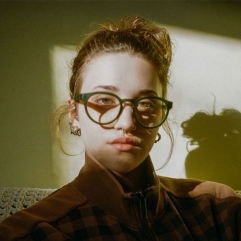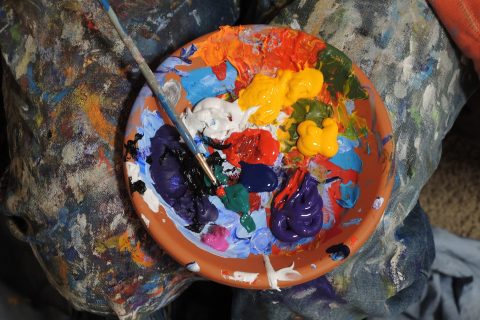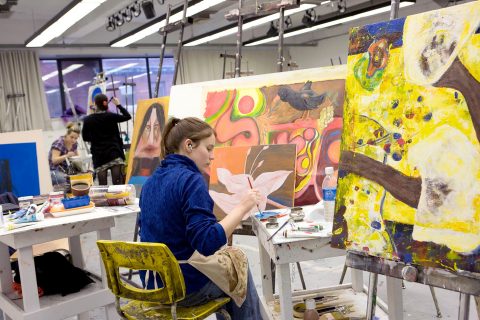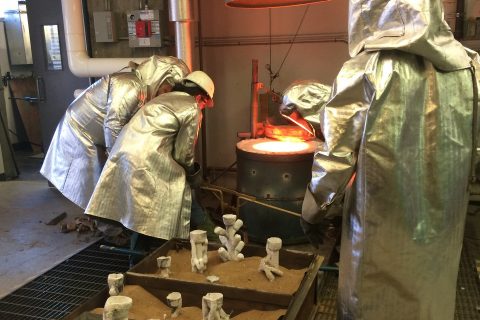Ceramics (BFA)
Why study Ceramics?
Ceramics offers endless possibilities between form and surface, from traditional techniques to digital technologies. When you study ceramics, you will be able to develop technical skills in hand building, slip casting, glazing and firing, as well as engage in contemporary art practices like installation and digital imagery with your work.
In Quebec’s only Ceramics program, you’ll learn a specialized practice that encompasses:
- Theory, history and practice of ceramics
- Immersing yourself in the technical process
- Exploring new ways of thinking about and discussing your work
- Engaging in collaborative projects across art disciplines
- Going on field trips and meeting visiting artists
You’ll practice in a communal atmosphere, sharing a studio, kiln and glaze room. You’ll learn from your instructors and visiting artists as well as your peers, taking part in a movement of ideas through the studio. Above all, you will develop a personal approach to ceramics based on your own interests and a unique body of work that you can build upon after graduation.
Program highlights
- Access to state-of-the-art Blauww kilns
- The Ceramics Students Association raises money for travel for student research trips and organizes an annual juried show of student work
Special funding for out-of-province students
Up to $4000 for undergraduate programs.
Program structure
A Bachelor of Fine Arts degree takes a minimum of three or four years (90 – 120 credits) of full-time study, depending on your academic background.
Program option
- Major in Ceramics (60 credits)
Major in Ceramics and develop individual studio work in a context that links contemporary art practice to a rich and diverse material history. Your ceramics courses will regularly feature special collaborative projects, field trips and visiting artists. In the Ceramics program, students investigate diverse subjects ranging from traditional craft practice to new technologies.
Courses
United States students: A U.S. Federal Student Aid-eligible version of this program is offered. This version meets all U.S. regulations (such as no co-operative education or e-courses) for eligible programs.
Admission criteria
This program is only available for Fall admission.
Minimum cut-off averages and course requirements
- Quebec CEGEP: DEC
- High School: C+
- ACT or SAT is NOT required
- Canadian curricula course requirements
- Accepted international qualifications
- International Baccalaureate (IB) diploma: 26
- International Baccalaureate Career-related Programme (CP): 4.3/7
- Baccalauréat français: 11
- British system of education (GCE):
- A-levels: At least two A-level exams CD or
- AS-levels: At least 4 AS-level exams with equivalent results or
- BTEC: Level 3 Diploma or Extended Diploma in a related subject area with equivalent results
- Additional information for British System of Education (GCE) applicants
- University Transfers (internal/external): C
Additional requirements for admission
Applicants must submit additional requirements for admission directly to the department.
- Letter of Intent
- Portfolio
Portfolio / Letter of intent
The portfolio of artwork for admission to a Studio Arts program should be a collection of your best and most recent work in visual arts. It should represent your individual interests, abilities and explorations. Consider visual, conceptual, and technical proficiency in selecting your best and most recent work.
If you are applying to more than one Fine Arts program, be sure to submit a separate portfolio for each program choice.
Your portfolio should contain:
- Minimum number of portfolio items: 15.
- Maximum number of portfolio items: 20.
- Each portfolio item must be a single digital file.
- Either recently completed or currently in progress.
- Include work that demonstrates your ability to work in a variety of media, in both two and three dimensions. Examples include drawings, paintings, prints, collage and other mixed media work, sculpture, ceramics, and fibres work.
- You may also include photographs, animation, film, video, audio recordings, and documentation of performance art.
- Please tailor your portfolio to the specific program area to which you are applying.
- Your work should show evidence of both technical skill and conceptual development. Basic abilities in drawing, composition and color-use must be demonstrated.
- You may not submit your portfolio via email or through other websites.
Letter of intent
Your letter of intent should be no longer than one page and written in English or French. In general, it should describe your educational background and any relevant experience in art, as well as your expectations in relation to the programs to which you are applying.
- What are your reasons for applying to this program? If you are particularly interested in an area within Studio Arts, please indicate why.
- Describe your educational background and any relevant experience.
- What are your goals and expectations in relation to this program?
Minimum cut-off averages should be used as indicators. The cut-off data may change depending on the applicant pool. Applicants who meet the stated minimum requirements are not guaranteed admission to these programs.
Application deadlines

FALL ENTRY (September)
Deadline: March 1
U.S. and international applicants: Apply no later than February 1 to allow time for immigration document processing. However, applying earlier is strongly recommended. Immigration processing times vary by country, and delays could prevent you from starting your studies on time.

WINTER ENTRY (January)
Admission to this program is available for the Fall Term only.
We reserve the right to close admission to a program at any time after the official deadline without prior notice.
Student story

Sydney Bocknek
Major in Ceramics
Clay and powder collide in the life of Ceramics student and Concordia Ski and Snowboard Club member Sydney Bocknek.
Other programs of interest

As a Studio Art major, you’ll have the flexibility to choose a concentration or combine any of our seven disciplines: Ceramics, Fibres and Material Practices, Intermedia/Cyberarts (Performance, Video, Electronic Arts), Painting and Drawing, Photography, Print Media, Sculpture and Installation.
Department
Faculty

Painting and Drawing fuses traditional expertise and technique with cutting edge, contemporary approaches to artmaking.
Department
Faculty

Our courses give students exposure to metal work, woodwork, moulding and casting, bronze and aluminum foundry work, public art practices, environmentally sustainable techniques, as well as a wide range of diverse materials and digital technologies.
Department
Faculty

